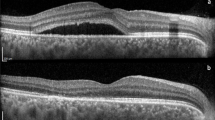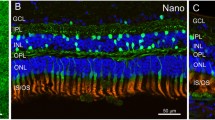Abstract
Retinitis pigmentosa (RP) is a common inherited retinal disease for which effective treatment is not yet known. This review sought to analyze the available medical literature covering the efficacy of different forms of laser treatment for RP in laboratory and clinical trials. The PubMed database was searched using the following phrases: “laser photocoagulation”, “subthreshold laser”, “nanolaser”, “micropulse laser”, “retinitis pigmentosa”, “rod–cone dystrophy”, and “retinal dystrophy”. Results were stratified as clinical or experimental studies. Six studies involving animal models and three studies involving human subjects that examined laser treatment in RP were found. Laboratory studies on rodents favored classic laser photocoagulation as the most effective therapy for slowing the progression of proto-oncogene tyrosine-protein kinase MER–related RP. Two clinical studies on humans suggested transient but robust functional benefits of subthreshold micropulse laser treatment in RP. The available material is too scarce to define laser treatment as a standard procedure to treat RP in humans. Nondamaging retinal laser therapy should be tested more intensively in clinical trials as there is no proven negative side effect of that treatment and the theoretical background, especially the chaperone and reparative roles of heat shock proteins elicited during the procedure, supports this form of RP management.
Similar content being viewed by others
References
Hamel C (2006) Retinitis pigmentosa. Orphanet J Rare Dis 1:40
Daiger SP, Sullivan LS, Bowne SJ (2013) Genes and mutations causing retinitis pigmentosa. Clin Genet 84:132–141
Garafalo AV, Cideciyan AV, Heon E, Sheplock R, Pearson A, WeiYang Yu C, Sumaroka A, Aguirre GD, Jacobson SG (2019) Progress in treating inherited retinal diseases: early subretinal gene therapy clinical trials and candidates for future initiatives. Prog Retin Eye Res 30:100827
Sudharsan R, Beltran WA (2019) Progress in gene therapy for rhodopsin autosomal dominant retinitis pigmentosa. Adv Exp Med Biol 1185:113–118
Lavinsky D, Wang J, Huie P et al (2016) Nondamaging retinal laser therapy: rationale and applications to the macula. Invest Ophthalmol Vis Sci 57:2488–2500
Yang JH et al (2016) Morphologic changes in the retina after selective retina therapy. Graefes Arch Clin Exp Ophthalmol 254(6):1099–1109
Bourne MC, Campbell DA, Tansley K (1938) Hereditary degeneration of the rat retina. Br J Ophthalmol 22(10):613–623
Mullen RJ, LaVail MM (1976) Inherited retinal dystrophy: primary defect in pigment epithelium determined with experimental rat chimeras. Science 192:799–801
D’Cruz PM et al (2000) Mutation of the receptor tyrosine kinase gene Mertk in the retinal dystrophic RCS rat. Human molecular genetics 9:645–651
Mackay DS et al (2010) Novel mutations in MERTK associated with childhood onset rod-cone dystrophy. Molecular vision 16:369–377
Evans DR, Green JS, Johnson GJ et al (2017) Novel 25 kb deletion of MERTK causes retinitis pigmentosa with severe progression. Invest Ophthalmol Vis Sci 58:1736–1737
Kang S, Lorach H, Bhuckory MB, Quan Y, Dalal R, Palanker D (2019) Retinal laser therapy preserves photoreceptors in a rodent model of MERTK-related retinitis pigmentosa. Transl Vis Sci Technol 8(4):19
Lorach H, Kang S, Dalal R, Bhuckory MB, Quan Y, Palanker D (2018) Long-term rescue of photoreceptors in a rodent model of retinitis pigmentosa associated with MERTK mutation. Sci Rep 8(1):11312
Quinn R (2005) Comparing rat’s to human’s age: how old is my rat in people years? Nutrition 21:775–777
Andreollo NA, dos Santos EF, Araújo MR, Lopes LR (2012) Rat’s age versus human’s age: what is the relationship? ABCD. Arquivos Brasileiros de Cirurgia Digestiva (São Paulo) 25(1):49–51
Sengupta P (2013) The laboratory rat: relating its age with human’s. Int J Prev Med 4(6):624–630
Ma J, Norton JC, Allen AC, Burns JB, Hasel KW, Burns JL, Sutcliffe JG, Travis GH (1995) Retinal degeneration slow (rds) in mouse results from simple insertion of a t haplotype-specific element into protein-coding exon II. Genomics 28(2):212–219
Xiao M, Sastry SM, Li ZY, Possin DE, Chang JH, Klock IB, Milam AH (1998) Effects of retinal laser photocoagulation on photoreceptor basic fibroblast growth factor and survival. Invest Ophthalmol Vis Sci 39(3):618–630
Humphrey MF, Parker C, Chu Y, Constable IJ (1993) Transient preservation of photoreceptors on the flanks of argon laser lesions in the RCS rat. Curr Eye Res 12(4):367–372
Behbehani MM, Bowyer DW, Ruffolo JJ, Kranias G (1984) Preservation of retinal function in the RCS rat by laser treatment. Retina 4:257–263
Ansell PL, Marshall J (1976) Laser induced phagocytosis in the pigment epithelium of the Hunter dystrophic rat. Br J Ophthalmol 60:819–828
Luttrull JK (2018) Improved retinal and visual function following panmacular subthreshold diode micropulse laser for retinitis pigmentosa. Eye (Lond) 32(6):1099–1110
Luttrull JK, Margolis BW (2016) Functionally guided retinal protective therapy for dry age-related macular and inherited retinal degenerations: a pilot study. Invest Ophthalmol Vis Sci 57(1):265–275
Williams LL, Shannon BT, Chambers RB, Leguire LE, Davidorf FH (1992) Systemic immunostimulation after retinal laser treatment in retinitis pigmentosa. Clin Immunol Immunopathol 64(1):78–83
Lewis GP, Erickson PA, Guérin CJ, Anderson DH, Fisher SK (1992) Basic fibroblast growth factor: a potential regulator of proliferation and intermediate filament expression in the retina. J Neurosci 12(10):3968–3978
Pittack C, Jones M, Reh TA (1991) Basic fibroblast growth factor induces retinal pigment epithelium to generate neural retina in vitro. Development 113(2):577–588
Rashid K, Akhtar-Schaefer I, Langmann T (2019) Microglia in retinal degeneration. Front Immunol 10:1975
Flaxel CJ, Adelman RA, Bailey ST, Fawzi A, Lim JI, Vemulakonda GA, G-s Y (2019) Diabetic retinopathy preferred practice pattern®. Ophthalmology. https://doi.org/10.1016/j.ophtha.2019.09.025
Olteanu M et al (1986) Laser applications in ophthalmology. In: Prokhorov AM, Ursu I (eds) Trends in quantum electronics. Springer, Berlin, Heidelberg
Stefánsson E (2006) Ocular oxygenation and the treatment of diabetic retinopathy. Surv Ophthalmol 51(4):364–380
Stefánsson E (2001) The therapeutic effects of retinal laser treatment and vitrectomy. A theory based on oxygen and vascular physiology. Acta Ophthalmol Scand 79(5):435–440
Chhablani J, Roh YJ, Jobling AI, Fletcher EL, Lek JJ, Bansal P, Guymer R, Luttrull JK (2018) Restorative retinal laser therapy: present state and future directions. Surv Ophthalmol 63(3):307–328
Ishida K, Yoshimura N, Yoshida M, Honda Y (1998) Upregulation of transforming growth factor-beta after panretinal photocoagulation. Invest Ophthalmol Vis Sci 39(5):801–807
Tababat-Khani P, de la Torre C, Canals F, Bennet H, Simo R, Hernandez C, Fex M, Agardh CD, Hansson O, Agardh E (2015) Photocoagulation of human retinal pigment epithelium in vitro: unravelling the effects on ARPE-19 by transcriptomics and proteomics. Acta Ophthalmol 93(4):348–354
Luttrull JK, Musch DC, Mainster MA (2005) Subthreshold diode micropulse photocoagulation for the treatment of clinically significant diabetic macular oedema. Br J Ophthalmol 89(1):74–80
Luttrull JK, Dorin G (2012) Subthreshold diode micropulse laser photocoagulation (SDM) as invisible retinal phototherapy for diabetic macular edema: a review. Curr Diabetes Rev 8(4):274–284
Luttrull JK, Chang DB, Margolis BW, Dorin G, Luttrull DK (2015) Laser resensitization of medically unresponsive neovascular age-related macular degeneration: efficacy and implications. Retina 35(6):1184–1194
Tavaria M, Gabriele T, Kola I, Anderson RL (1996) A hitchhiker’s guide to the human Hsp70 family. Cell Stress Chaperones 1(1):23–28
Lüders J, Demand J, Höhfeld J (2000) The ubiquitin-related BAG-1 provides a link between the molecular chaperones Hsc70/Hsp70 and the proteasome. The Journal of Biological Chemistry 275(7):4613–4617
Beere HM, Wolf BB, Cain K, Mosser DD, Mahboubi A, Kuwana T, Tailor P, Morimoto RI, Cohen GM, Green DR (2000) Heat-shock protein 70 inhibits apoptosis by preventing recruitment of procaspase-9 to the Apaf-1 apoptosome. Nature Cell Biology 2(8):469–475
Kern K, Mertineit CL, Brinkmann R, Miura Y (2018) Expression of heat shock protein 70 and cell death kinetics after different thermal impacts on cultured retinal pigment epithelial cells. Exp Eye Res 170:117–126
Sramek C, Mackanos M, Spitler R, Leung LS, Nomoto H, Contag CH, Palanker D (2011) Non-damaging retinal phototherapy: dynamic range of heat shock protein expression. Invest Ophthalmol Vis Sci 52(3):1780–1787
Wang J, Quan Y, Dalal R, Palanker D (2017) Comparison of continuous-wave and micropulse modulation in retinal laser therapy. Invest Ophthalmol Vis Sci 58(11):4722–4732
Inagaki K, Shuo T, Katakura K, Ebihara N, Murakami A, Ohkoshi K (2015) Sublethal photothermal stimulation with a micropulse laser induces heat shock protein expression in ARPE-19 cells. J Ophthalmol 2015:729792
Luttrull JK, Sinclair SH (2014) Safety of transfoveal subthreshold diode micropulse laser for fovea-involving diabetic macular edema in eyes with good visual acuity. Retina 34(10):2010–2020
Desmettre TJ, Mordon SR, Buzawa DM, Mainster MA (2006) Micropulse and continuous wave diode retinal photocoagulation: visible and subvisible lesion parameters. Br J Ophthalmol 90(6):709–712
Koriyama Y, Furukawa A (2015) Role of heat shock protein 70 in retinitis pigmentosa and a novel strategy for treatment. Brain Nerve 67(12):1523–1531
Valdés-Sánchez L, Calado SM, de la Cerda B, Aramburu A, García-Delgado AB, Massalini S, Montero-Sánchez A, Bhatia V, Rodríguez-Bocanegra E, Diez-Lloret A, Rodríguez-Martínez D, Chakarova C, Bhattacharya SS, Díaz-Corrales FJ (2019) Retinal pigment epithelium degeneration caused by aggregation of PRPF31 and the role of HSP70 family of proteins. Mol Med 26(1):1
Subrizi A, Toropainen E, Ramsay E, Airaksinen AJ, Kaarniranta K, Urtti A (2015) Oxidative stress protection by exogenous delivery of rhHsp70 chaperone to the retinal pigment epithelium (RPE), a possible therapeutic strategy against RPE degeneration. Pharm Res 32(1):211–221
Koyama Y, Kaidzu S, Kim YC, Matsuoka Y, Ishihara T, Ohira A, Tanito M (2019) Suppression of light-induced retinal degeneration by quercetin via the AP-1 pathway in rats. Antioxidants (Basel) 8(4)
Mainster MA (1986) Wavelength selection in macular photocoagulation. Tissue optics, thermal effects, and laser systems. Ophthalmology 93:952–958
Luttrull JK, Sramek C, Palanker D, Spink CJ, Musch DC (2012) Long-term safety, high-resolution imaging, and tissue temperature modeling of subvisible diode micropulse photocoagulation for retinovascular macular edema. Retina 32(2):375–386
Vujosevic S, Martini F, Longhin E, Convento E, Cavarzeran F, Midena E (2015) Subthreshold micropulse yellow laser versus subthreshold micropulse infrared laser in center-involving diabetic macular edema: morphologic and functional safety. Retina 35(8):1594–1603
Vujosevic S, Martini F, Convento E, Longhin E, Kotsafti O, Parrozzani R, Midena E (2013) Subthreshold laser therapy for diabetic macular edema: metabolic and safety issues. Curr Med Chem 20(26):3267–3271
Gawęcki M (2015) Increase in central retinal edema after subthreshold diode micropulse laser treatment of chronic central serous chorioretinopathy. Case Rep Ophthalmol Med 2015:813414
Author information
Authors and Affiliations
Contributions
Maciej Gawęcki—design of the study, data analysis, and preparation of the manuscript.
Corresponding author
Ethics declarations
Conflict of interest
The author declares that he has no conflicts of interest. The author alone is responsible for the content and writing of this paper.
Additional information
Publisher’s note
Springer Nature remains neutral with regard to jurisdictional claims in published maps and institutional affiliations.
Rights and permissions
About this article
Cite this article
Gawęcki, M. Laser treatment in retinitis pigmentosa-a review. Lasers Med Sci 35, 1663–1670 (2020). https://doi.org/10.1007/s10103-020-03036-9
Received:
Accepted:
Published:
Issue Date:
DOI: https://doi.org/10.1007/s10103-020-03036-9




